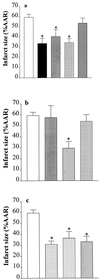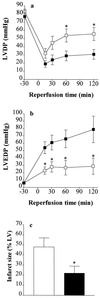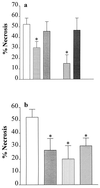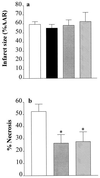Inhibition of the activity of poly(ADP ribose) synthetase reduces ischemia-reperfusion injury in the heart and skeletal muscle
- PMID: 9012844
- PMCID: PMC19573
- DOI: 10.1073/pnas.94.2.679
Inhibition of the activity of poly(ADP ribose) synthetase reduces ischemia-reperfusion injury in the heart and skeletal muscle
Abstract
Reperfusion of the ischemic myocardium results in the generation of oxygen-derived free radicals, NO, and presumably peroxynitrite. These, in turn, may cause strand breaks in DNA, which activate the nuclear enzyme poly(ADP ribose) synthetase (PARS). This results in a rapid depletion of intracellular NAD and ATP. When this reaction is excessive, there is ultimately cell death. Here we demonstrate that 3-aminobenzamide (and several other, chemically distinct, inhibitors of PARS activity) reduces the infarct size caused by ischemia and reperfusion of the heart or skeletal muscle of the rabbit. Inhibition of PARS activity also attenuates the myocardial dysfunction caused by global ischemia and reperfusion in the isolated, perfused heart of the rabbit. In skeletal muscle, inhibition of the activity of neuronal NO synthase reduces infarct size, indicating that the formation of NO contributes to the activation of PARS there. There is no significant neuronal NO synthase activity in the heart, and hence NO synthase inhibitors did not reduce myocardial infarct size. Thus, activation of PARS contributes to the cell death caused by ischemia-reperfusion, and PARS inhibitors may constitute a novel therapy for ischemia-reperfusion injury.
Figures




References
-
- Satoh M S, Lindahl T. Nature (London) 1992;356:356–358. - PubMed
-
- Ikai K, Ueda K. J Histochem Cytochem. 1983;31:1261–1264. - PubMed
-
- Hyslop P A, Hinshaw D B, Halsey W A, Schraufstatter I U, Sauerheber R D, Spraggs R G, Jackson J H, Cochrane C G. J Biol Chem. 1988;263:1665–1675. - PubMed
-
- Thies R L, Autor A P. Arch Biochem Biophys. 1991;286:353–363. - PubMed
Publication types
MeSH terms
Substances
LinkOut - more resources
Full Text Sources
Other Literature Sources
Medical
Miscellaneous

